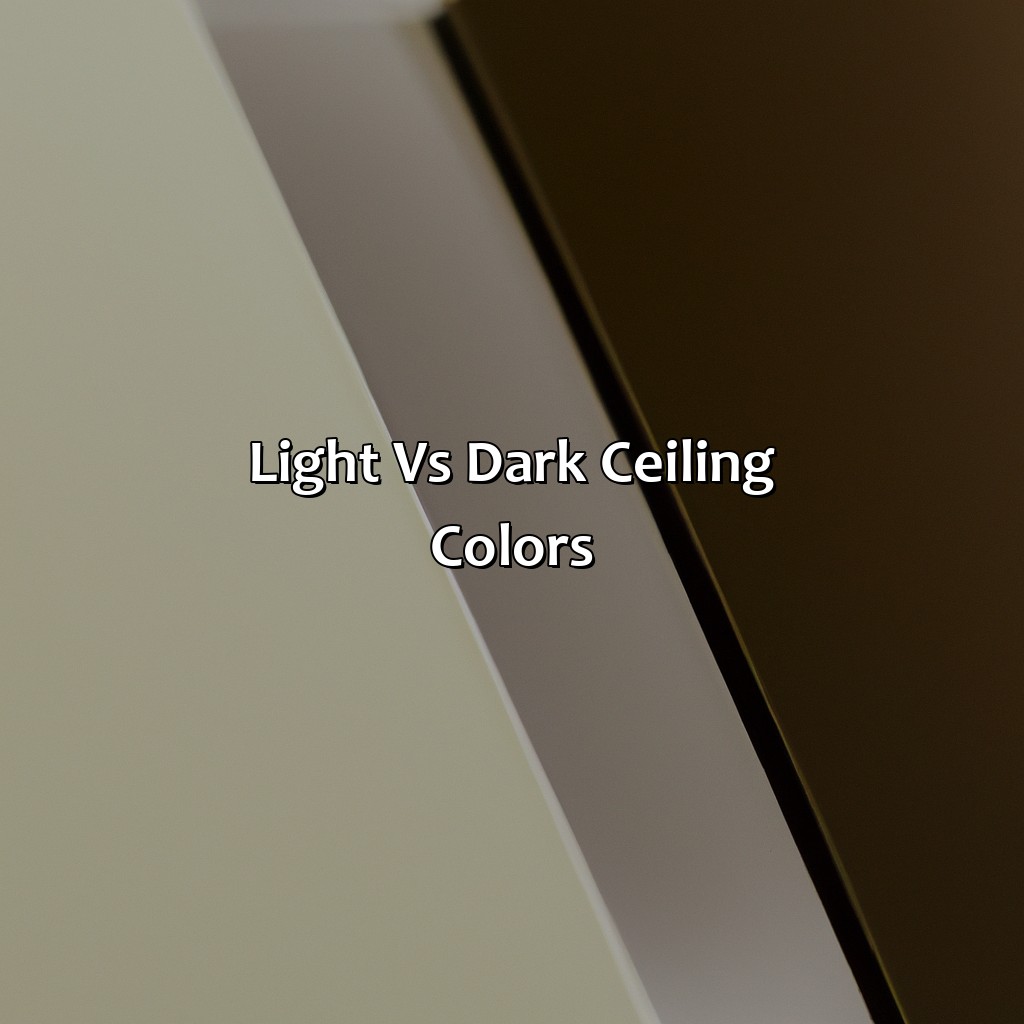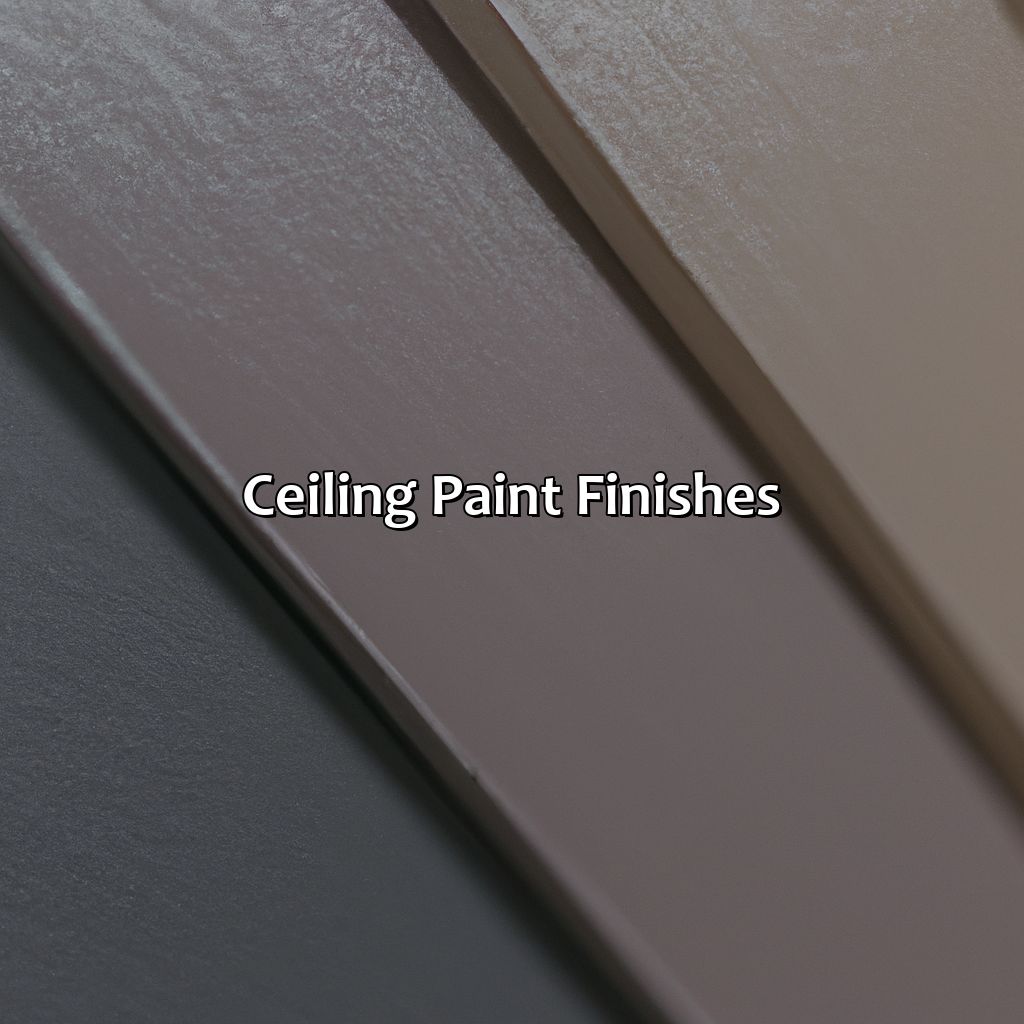Key Takeaway:
- Choosing the right ceiling color is crucial to complete the overall home decor and interior design. It can either complement or contrast with the wall and floor colors, creating a cohesive look for the room.
- Factors to consider when choosing a ceiling color include the color palette, color scheme, and the room’s natural and artificial lighting. Neutral colors like white and beige are timeless, while bold colors like navy blue or emerald green can add a pop of color in a minimalist or maximalist room. Warm colors like yellow or red can create a welcoming ambiance, while cool colors like blue or green can provide a calming effect.
- Light ceiling colors can make a room feel brighter and more spacious, while dark ceiling colors can create a cozy and intimate atmosphere. For the living room, a statement color can be used as a focal point, while for the bedroom, calming and soothing colors like lavender or light blue can promote relaxation. In the kitchen, energizing and uplifting colors like yellow or orange can stimulate the appetite. In choosing a ceiling paint finish, consider the texture of the ceiling and choose from matte, glossy, or satin finishes.
Choosing the Right Ceiling Color

Photo Credits: colorscombo.com by Joe Garcia
Choosing the perfect ceiling shade requires considering many aspects. Our section on Choosing the Right Ceiling Color is here to help! It covers:
- The importance of ceiling color
- Color palette
- Color schemes
- Trends
- Color psychology
- Mood and ambience
- Personal taste
Get ready to make the right choice!
Importance of the Ceiling Color
Ceiling color is a crucial element in room decor as it can affect the overall look and feel of a space. The importance of the ceiling color lies in its ability to create an illusion of height, depth, and brightness. It also helps to tie together different design elements in a room.
In choosing the right ceiling color, several factors need to be considered, such as room size and shape, natural lighting, and existing decor. A lighter shade can make a smaller room appear more expansive and brighter, while darker hues can add coziness and depth to larger spaces.
Lighter shades of white or off-white are typically favored for ceilings because they reflect light well and create an airy feel. In contrast, darker colors like navy blue or chocolate brown offer more warmth and intimacy to a room’s ambiance.
The best ceiling colors vary by each room’s function. For instance, living rooms work well with light-colored ceilings that match the walls’ hue due to their social nature. Bedrooms benefit from various finishes such as matte or eggshell paint that showcases lighting fixtures or chandeliers. Kitchens require bright surfaces that make small spaces seem more extensive than they are.
Choosing the right paint finish is another crucial factor in achieving an ideal ceiling color result. Choosing semi-gloss paint for durability or flat paint for minor flaws ultimately depends on preference.
To achieve a flawless finish when painting your ceilings, proper surface preparation is critical. Using high-quality tools like extension poles offers better reach and accessibility will come in handy during any painting project. Painting techniques such as cutting into edges first before rolling help avoid drips and smudges.
In summary, selecting the perfect ceiling color is fundamental because it creates balance within the entire décor scheme while adding depth or artistically tying-in aerial design features’ other elements. Highlighting unique architectural details through texture adds dimensionality to your roof while invigorating surrounding space. Maybe Texture makes attractively homey-feelings. What we want to achieve can be influenced by the ceiling color, so it’s vital to choose wisely.
Choosing the right ceiling color is all about finding the perfect shade to set the mood and complement your decor – color scheme is key!
Factors to Consider in Choosing a Ceiling Color
The color of the ceiling plays a crucial role in enhancing the overall look and feel of any room. It can open up space visually, create an illusion of height or depth, and even impact the mood of a room. Here are some important aspects to keep in mind while choosing a color palette for the ceiling:
- Accent Color: Consider using an accent color on your ceiling, which complements your wall’s color scheme or adds personality to your space.
- Neutral Colors: Neutral colors like white, beige, ivory or cream can open up the room and provide a timeless classic touch to any style of home decor.
- Bold Colors: For those who want to make a statement in their interiors, using bold colors like bright reds, blues, yellows or greens can add an energizing pop of color to your living spaces.
- Pastel Colors: Soft pastels like baby pink or pale blue can strike calm vibes in bedrooms and nurseries.
- Monochromatic Colors: One-color themes that vary by shades can create a more cohesive look yet offer visual interest with subtle contrasts.
- Complementary Colors: Choose two hues from opposite sides of the spectrum to bring balance and freshness.
- Analogous Colors: Choose two-three shades next to each other on the color wheel for a seamless blend.
- Warm Vs. Cool Colors: Cool colors such as cool blue tones can evoke tranquility and relaxation whereas warm colors like warm reds and oranges tend to stimulate energy & create vibrancy.
The unique aspect about choosing a ceiling’s color is its ability to either blend with other décor elements like furniture or act as a prominent design feature itself. Depending upon your taste, you can opt for trendy modern schemes (think black) or go retro rustic with beige-browns.
Ceiling painting dates back to ancient times when Romans used it often in their homes decorated with frescoes. “Color is both objective and subjective,” said Leatrice Eiseman, the founder of The Eiseman Center for Color Information and Training and Pantone’s color consultant. “Color has both physical and psychological effects on humans.”
Is your ceiling white or black? It’s the ultimate yin and yang of home decor.
Light vs. Dark Ceiling Colors

Photo Credits: colorscombo.com by Jordan Sanchez
Which ceiling color to choose? Let us discuss the different advantages of light and dark colors!
Light colors bring brightness and an illusion of a larger room. Whereas, dark colors create a cozier atmosphere. Let’s look at the benefits of light colors: brightness, luminosity. And dark colors: creating intimacy.
Benefits of Light Ceiling Colors
Light Ceiling Colors Can Make Your Room Look Bigger
Using light colors for your ceiling can have several positive effects on your room. The light hue can give an illusion of openness and height which makes the room appear bigger than it is. This effect is especially apparent if you use a bright color that reflects natural light.
- Creates the impression of spaciousness and openness, making rooms look larger.
- Reflects more natural light and brightens up space.
- Gives a fresher look to the interior design.
- Makes it easier to cover imperfections and mistakes when painting over
Complementing Light Wall Colors with Light Ceiling Colors
Using light ceiling colors will also blend well with various wall colors. You’ll have more freedom in choosing appropriate hues that fit just about any style, adding balance to your dwelling’s design. However, using dark hues on the walls puts emphasis on their depth while still providing that extra dimension with high ceilings.
Using Light Ceiling Colors Doesn’t Mean It Has To Be White
Take advantage of lighter tones’ versatility – they’re not just limited to white or neutral shades anymore! Consider pale blues, yellows or greens – pastels are in this season along with other ‘muted’ colors that can match a monochrome design scheme.
Make Your Space Shine With Light-Colored Ceilings
Still unsure whether you should go for a brighter hue? Envision how fabulous it could be. Playing around with hues may seem risky, but having a light-colored ceiling has been proven to enhance different types of interiors. Don’t let fear hold you back from trying something new – many people have come before you and loved what they tried! Give the shades a chance, who knows what they can do?
Give your ceiling a touch of drama with a dark color – it’s like a little black dress for your room.
Benefits of Dark Ceiling Colors
Dark Ceiling Colors- A Superior Choice for a Bold Look
Dark ceiling colors have the power to create a bold and unique look that accentuates your room’s design. By choosing darker shades, you can emphasize your room’s features and add depth to its architecture. Here are some of the benefits that come with using dark ceiling colors:
- Creates a cozy ambiance
- Emphasizes decorative moldings
- Makes the room appear larger
- Showcases intricate lighting fixtures
Additionally, experimenting with dark ceiling colors provides an opportunity to be more daring and creative. Whether you choose navy blue, deep grey, or black, you can be sure that your choice of color will stand out in any space.
By adding this element of grandeur to your decor, you can transform how people perceive your room. Dark ceilings have become increasingly popular among homeowners and industry experts alike due to their unique charm.
For instance, a designer once used a black-painted ceiling to accentuate her client’s modern dining hall with copper light fixtures. The result was mesmerizing; the combination created an enchanting atmosphere perfect for dinner parties.
Find the perfect hue for every room, from serene blues for the bedroom to bold yellows for the kitchen.
Best Ceiling Colors by Room

Photo Credits: colorscombo.com by Kevin Lopez
Wanna know the best ceiling colors for each room? Check out this section on “Best Ceiling Colors by Room.” Learn about the perks of picking just the right hue for different purposes. There are three subsections: “Living Room,” “Bedroom,” and “Kitchen.” Consider keywords such as “statement color” or “calming color.” Also, factor in room size, furniture color, and undertones. Look into tools like color swatches and color consultation to find the perfect color for your space.
Best Ceiling Colors for the Living Room
Choosing the perfect ceiling color for your living room can be challenging. The statement color of your ceiling can greatly affect the atmosphere and mood of the room, making it a crucial decision. To help you choose, here are some factors to consider:
- Room Size: In large rooms, a darker hue can create an intimate and cozy ambiance, while a lighter shade can make the space feel more open.
- Ceiling Height: If your ceiling is low, opt for lighter shades to create an illusion of height. For high ceilings, darker shades can help bring down the perception of space.
- Natural and Artificial Light: Lighting plays a significant role in how your color choice will appear on the ceiling. Consider whether your room receives more natural or artificial light when selecting colors.
Undertones are important to take into account as well. The undertones in your furniture, flooring and wall color should complement your chosen ceiling color. In terms of adding color accents, swatches or samples can aid in determining whether or not they would clash with existing furnishings.
It’s always a good idea to seek a professional color consultation if you’re hesitant about which shade to pick. By doing so, you’ll get an expert opinion on what works best for the size of your living room and individual style preferences.
A colleague had once painted their living room’s ceiling with dark navy blue paint known for being tricky due to its strong pigmentation. After going through multiple coats with no success at hiding roller marks, frustration levels increased until they contacted a professional painter who advised them on a new approach resulting in satisfaction and relief from unsuccessful DIY endeavors.
Transform your bedroom into a peaceful sanctuary with these calming and soothing ceiling colors.
Best Ceiling Colors for the Bedroom
Creating a relaxing atmosphere in the bedroom is essential for a good night’s sleep. The color of the ceiling plays a vital role in achieving this calming environment. Here are some recommended ceiling colors to enhance your bedroom decor and add to its soothing ambiance.
- A soft grey ceiling provides depth and interest to any bedroom.
- A light blue ceiling gives an earthy touch to the room, helping you relax while sleeping.
- White ceilings give off a clean and crisp look while working perfectly with the walls’ colors.
- Pale pink ceilings add warmth and character to any bedroom. Pink can also help calm anxiety and reduce stress levels.
- Neutral beige complements any décor style and creates an inviting atmosphere in the bedroom.
- If you’re feeling daring, opting for bold accent walls will stand out beautifully against white or pale blue ceilings. These include shades like deep reds, vibrant oranges, or moss greens for statement flair.
While these colors may be suitable for most bedrooms, other factors must be considered when selecting the perfect calming color scheme such as lighting, furniture, wall paint, etc.
A recent study published in Sleep Science analyzed how different colors affected participants’ sleep quality. Researchers found that muted shades of blue could lead to better sleep quality than warmer hues like orange or deep brown.
One couple shared their experience with painting their bedroom’s ceiling with soft cool grey-toned paints. They felt that it made their space more peaceful, luxurious, and comforting – leading them into better sleep routines independently increased satisfaction in their relationship together by waking up less tired and irritable.
Add some zest to your kitchen with an energizing and uplifting ceiling color.
Best Ceiling Colors for the Kitchen
Using the right color for your kitchen ceiling can enhance the outlook of your kitchen and set a positive mood. When considering ceiling colors, there are few points to consider like size, light source, and nearby wall colors.
- White is an optimal choice for the kitchen ceiling as it reflects rather than absorbs color from the walls.
- Light grey creates a subtle contrast with either white or bold colored walls
- An energizing color like soft orange or sunny yellow can add a refreshing look and uplifts you with joy.
- For a dramatic appearance, try using dark shades of blue or green creating depth to flat ceilings.
- If you want to maintain harmony between the upper part of your room and decor use wood-inspired tones on the ceiling.
- Using white paint will fit in any decorative style and gives a polished look to your kitchen.
For added dimension, try painting the center part of your kitchen’s coffered ceiling with uplifting color that matches other elements in your room, showing an open area.
In earlier days kitchens were seen as a utility space with no effort beyond keeping it clean and functional during cooking events. Over time designers have started giving attention to kitchens by decorating them luminating primary spots which uplifts residents’ moods.
Overall, choosing energetic colors like bright and warm tones reflect better off light sources, making ceilings look higher giving an airy ambiance compared to darker hues on ceilings constricts space making it feel lower. Update variety of blues featuring cerulean, turquoise helps in calming down while whipping up dinner or sitting around over coffee with friends which interrupts mundane life. Choose the right ceiling paint finish and your guests won’t be able to take their eyes off the ceiling (and maybe even forget to compliment your new sofa).
Ceiling Paint Finishes

Photo Credits: colorscombo.com by Arthur Baker
When selecting the ideal paint finish for your ceiling, search through “Ceiling Paint Finishes”. This includes options such as matte, glossy, satin and sheen. Also, take into account “Factors to Consider in Choosing a Ceiling Paint Finish”, such as the texture of your ceiling.
Types of Ceiling Paint Finishes
Ceiling Paint Finishes play a significant role in determining the overall look and feel of a room. Choosing the right one can give your ceiling a stunning finish while protecting it from damage caused by moisture, stains or mildew. The selection of Ceiling Paint Finishes should depend on several factors, including the desired level of shine, ease of application and durability.
- Matte Finish: Matte finishes have a smooth and non-reflective effect that works well for concealing surface imperfections. They are ideal for low-traffic rooms without high levels of moisture and humidity.
- Glossy Finish: Glossy finishes create a shiny effect that adds depth to small rooms with limited natural light. However, they also highlight surface flaws and require meticulous preparation before application.
- Satin Finish: Satin finishes strike a balance between matte and glossy effects. They provide some sheen while still being able to conceal flaws to some extent. Satin is widely used in high-traffic rooms such as kitchens as it repels dirt better than matte finish paints.
- Sheen: Sheen defines the amount of shine that paint gives off when hit by light. It is measured on an individual scale ranging from 0 to 100 in units known as “gloss units.” Higher gloss units represent higher levels of sheen.
It’s essential to choose the right Ceiling Paint Finish since it affects your room’s ambiance and beauty. Consider not only your aesthetic preference but also what suits the room’s function best. Additionally, ensure you get good quality paint that’s easy to maintain over time.
Pro Tip: When choosing Ceiling Paint Finishes, go for high-quality paints since they may require fewer coats than lower quality alternatives. Opt for easy-to-clean options since maintaining the ceiling can be challenging if it’s frequently exposed to smoke or cooking fumes.
Texture can add depth and personality to your ceiling paint finish, so don’t be afraid to experiment with different techniques.
Factors to Consider in Choosing a Ceiling Paint Finish
When selecting the perfect paint finish for your ceiling, it is essential to consider various factors. The right ceiling paint finish can add depth and texture to a room, and also the right choice can transform the overall look of your space.
- Room Purpose – Different rooms have varying functions, which means they require different finishes. Determine whether the room has high or low traffic, whether it’s a place for display or relaxation.
- Budget – Ceiling paint finishes come at different prices. A budget-friendly option can be a great option if you are looking to save on costs.
- Aesthetics – The appearance of various ceiling finishes differs. While some folks may prefer a glossy look, others may want their ceilings to pop.
It’s worth knowing that incorporating texture into your ceiling paint is always an excellent choice; this helps elevate its aesthetic appeal. Additionally, when deciding on the perfect paint finish for your ceiling, be sure to take into account natural light conditions in your home before making any decision.
Did you know that adding texture to your ceiling not only adds value to your home but also hides imperfections? According to sources like Bob Vila and Better Homes & Gardens, textured coatings or popcorn-style ceilings were once very popular but are now outdated styles.
Don’t forget to stretch before painting the ceiling – you’ll need to be limber to avoid a neck cramp.
Ceiling Painting Tips

Photo Credits: colorscombo.com by Dylan Adams
For a successful DIY project, plan and organize for painting your ceiling. Preparing the surface, selecting the proper painting tools, and using the right techniques are key. Following these steps can give you an eco-friendly, cost-efficient, and long-lasting finish without hiring help.
Preparing the Ceiling Surface
Before painting your ceiling, it is crucial to prepare the surface to ensure that the paint adheres properly and lasts longer. A well-prepared ceiling can also make the whole DIY project cost-effective and long-lasting.
To prepare the ceiling surface, follow these three steps:
- Clean the ceiling with a broom or vacuum to remove dust and debris.
- Repair any cracks or holes by filling them with spackle or joint compound. Sand the patched areas smooth once they are dry.
- Apply a coat of stain-blocking primer to prevent any stains or discoloration from showing through the new paint.
It’s essential to take these steps before painting your ceiling as they help create a sustainable and eco-friendly DIY project. A properly cleaned and repaired surface can minimize waste by eliminating the need for rework.
By following these steps, your ceiling will be ready for painting, ensuring that you achieve an aesthetically pleasing result.
Choosing the right painting tools is key to avoiding a ceiling disaster – trust me, I learned the hard way.
Choosing the Right Painting Tools
When it comes to painting your ceiling, choosing the right painting tools is a crucial step to ensure a smooth and efficient process. Here’s what you need to keep in mind:
- Invest in high-quality brushes and rollers that can handle the thickness of ceiling paint. A long-handled roller will also make it easier to reach higher areas without straining yourself.
- Use painter’s tape to protect walls and trim from accidental splatters or smudges, creating cleaner lines.
- Consider using an extendable pole for your rollers so you can cover larger surfaces more easily without having to constantly reposition your ladder.
- If using airless sprayers, make sure they are specifically designed for use with ceiling paints. Otherwise, you may end up wasting time and money when the paint dries too quickly or clogs up mid-way through the job.
- Use drop cloths or plastic sheets to cover flooring and furniture to avoid messy clean-up situations after finishing the job.
- In selecting a good quality paintbrush, choose one that will help you achieve an optimal finish on flat ceilings by maintaining an even spread pattern across each stroke.
Choosing the right painting tools will ensure that your final product is both stunning and impressive. Additionally, it will help guarantee that any wasted effort in sub-par results due to a lack of preparation has been avoided.
It’s essential not just considering what tools would work best but also seeking out which creative techniques could improve their usage; there are many diverse ways of using brushes or paint sprayers for precise finishes.
One true fact: According to Behr Premium Plus Ceiling Paint manufacturers, it takes 4-hours minimum after painting before allowing foot traffic on your newly painted ceiling surface area.
Why hire a professional painter when you can just paint your ceiling like a pro with these simple techniques?
Techniques in Painting the Ceiling
Painting a ceiling can be a challenging task, but with the right techniques, it can be made simpler and deliver great results. Here’s how you can perfect your techniques in painting the ceiling:
- Prepping – Start by prepping your workspace. Remove any furniture or fixtures that may get affected by paint splatters. Cover the floor and walls with drop cloths to prevent unwanted stains.
- Cutting In – Before rolling or spraying, use an angled brush to cut-in along the edges where the wall meets the ceiling for a clean look.
- Rolling Method – Load your roller with paint and roll it on the surface in sections, applying even pressure. Overlap each new section slightly with the previous one and make sure not to overload the roller with too much paint.
- Spraying Method – Using a spray machine is more efficient but takes some practice to master. Work in small sections and apply a light coat of mist ensuring uniform coverage.
- Drying Time – Allow sufficient drying time between coats as specified by manufacturer’s instructions and if required start with 2nd coat until desired color depth is achieved.
It’s essential to prep well before any painting job considering factors like room orientation, natural light availability, type of paint used when deciding the technique for painting your ceiling.
True story- A friend once painted his living room ceiling brown instead of white; it ended up coming out looking yellow due to poor lighting in his home! Therefore, proper prep work before choosing either of these techniques is necessary as this can save you from spending money on supplies and effort wasted on wrong choices.
Why settle for just one question when you can have a whole section dedicated to your confusion?
Frequently Asked Questions

Photo Credits: colorscombo.com by Kevin Perez
Questions about what ceiling color to choose for a room? You’re in luck! Our “Frequently Asked Questions” section on the topic is here! We have the best ceiling paints on the market. Plus, find out if you can add texture to your ceiling paint!
How to Determine the Right Ceiling Color for a Room?
Choosing the perfect ceiling color for a room can be a daunting task, but it is crucial to achieve the desired look and ambiance. One must consider several factors before making the final decision. Here’s a three-step guide on how to determine the best ceiling color for your room:
- Analyze the existing colors: Look at your walls, flooring, and furniture to understand their exact colors and shades. Determine whether they are light or dark. This will help you choose complementary or contrasting hues.
- Consider the ceiling height: Opt for lighter shades if your ceiling is low as it will create an illusion of height. On the other hand, darker hues create an intimate space by bringing down tall ceilings.
- Think about lighting: Carefully evaluate natural and artificial lighting in the room as it affects how colors appear in different times of the day.
For some additional tips on finding your perfect ceiling paint color, consult interior design resources and talk to professional painters who can provide expert advice tailored to your needs.
Understanding these details should help you decide which direction to take when selecting a finish that makes your space sing without overcomplicating things with unnecessary details.
On top of that, you can also experiment with various patterns and textures to add layers of sophistication and uniqueness to your home decor without being too overwhelming.
If you’re still stuck choosing which hue you’d like in your living room theme or kitchen area update, why not try talking to a mate who has recently gone through something similar? They may have some insights from their own experiences on how they decided what worked (or didn’t work) for their tastes!
Before you pick a ceiling paint, make sure it doesn’t have the same consistency as cement.
What are the Best Ceiling Paints in the Market?
There are various options available in the market when it comes to ceiling paints. Here are the best ones:
- Benjamin Moore Waterborne Ceiling Paint – It provides a flat, glare-free finish, ideal for concealing blemishes and imperfections on the ceiling surface.
- Zinsser Perma-White Mold & Mildew Proof Interior Paint – Perma-White not only retains the initial whiteness of your ceiling but also inhibits mold and mildew growth, perfect for areas with high moisture levels.
- Sherwin-Williams ProMar 200 Zero VOC Interior Latex – A professional-grade ceiling paint that offers excellent coverage, durability with zero VOC, making it safe for you and the environment.
- Kilz Color Change Ceiling Paint – Kilz ceiling paint saves you time by eliminating the need for priming before painting. This product applies as pink but dries to a white finish, highlighting areas where another coat is required.
When selecting the best ceiling paint in the market to meet your needs, you should look for products that offer superior hiding power, excellent adhesion, and easy application.
If you’re seeking an affordable option with top-notch performance aspects, ProMar 200 Zero VOC Interior Latex by Sherwin-Williams would be an ideal choice for your home.
Painting a ceiling can be a daunting task, but missing out on using good quality will prove detrimental in the long run. Therefore to avoid regretting later on not using good quality paint on your ceilings, invest in these top-performing brands’ products.
Add texture to your ceiling paint if you want to feel like you’re sleeping under the stars, but without the cold and bugs.
Can I Add Texture to My Ceiling Paint?
Texture can add interest and depth to a ceiling, but can you add texture to your ceiling paint? Yes, it is possible.
Here’s a 5-step guide on how you can add texture to your ceiling paint:
- Choose the type of texture you want to achieve. You can use sand, joint compound, or other texturizing materials.
- Mix the texturizing material with your chosen ceiling paint.
- Apply the mixture using different tools such as rollers, brushes, or trowels to create the desired pattern or effect.
- Allow the paint and texture mixture to dry completely before adding an additional coat if desired.
- Clean all tools immediately after using them with warm water and soap.
Adding texture to your ceiling paint can be a fun and creative DIY project that can enhance any room in your home.
If you’re concerned about dust and dirt accumulation on textured ceilings, it may help to choose a higher gloss finish for easier cleaning.
Pro Tip: Before starting a ceiling painting project that involves texturizing, practice first on a small surface such as cardboard or scrap wood to test out the technique and consistency of your mixture.
Five Facts About What Color To Paint Your Ceiling:
- ✅ A white ceiling is a classic and versatile choice that can make a room feel brighter and more spacious. (Source: Bob Vila)
- ✅ A colored or patterned ceiling can add visual interest and depth to a room, but it may also make the ceiling appear lower. (Source: HGTV)
- ✅ Darker ceiling colors can create a cozy and intimate atmosphere, while lighter colors can make a room feel airier and more open. (Source: Sherwin-Williams)
- ✅ Consider the room’s natural lighting and the color of the walls when choosing a ceiling color. (Source: Benjamin Moore)
- ✅ Don’t be afraid to experiment with different colors and finishes, and remember that paint can always be changed. (Source: Real Simple)
FAQs about What Color Should I Paint My Ceiling
What color should I paint my ceiling in a small room?
The color of your ceiling can greatly impact the feeling of a small room. To make the ceiling seem higher, choose a light color such as white or a pale blue. If you want to make the room feel cozy, opt for a warmer color such as a soft beige.
What color should I paint my ceiling to match my walls?
If you want your ceiling to blend with your walls, choose a lighter shade of the wall color. For example, if your walls are painted a light blue, choose a slightly lighter shade of blue for the ceiling. This will create a cohesive look without being too overwhelming.
What color should I paint my ceiling to make the room seem larger?
To make a room seem larger, choose a light and bright color for your ceiling such as white or a light yellow. These colors can reflect light and give the illusion of a larger space.
What color should I paint my ceiling with a dark wall color?
If your walls are a darker color, consider painting the ceiling a lighter color such as white or a light gray. This will help balance out the dark color and prevent the room from feeling too small or closed in.
What color should I paint my ceiling in a room with a lot of natural light?
If your room gets a lot of natural light, you can experiment with different colors for your ceiling. Try painting it a light blue or green to complement the natural surroundings. Alternatively, you could paint the ceiling a bold color to create a dramatic look.
What color should I paint my ceiling in a room with low ceilings?
Low ceilings can make a room feel cramped and uncomfortable. To combat this, choose a light color for your ceiling such as white or a pale blue. This will help create the illusion of a higher ceiling and make the room feel more spacious.






